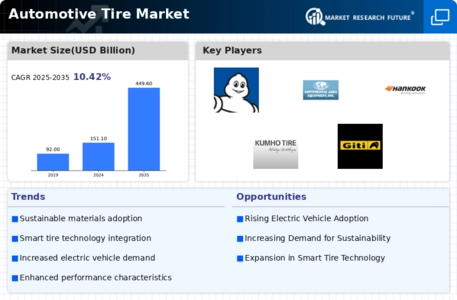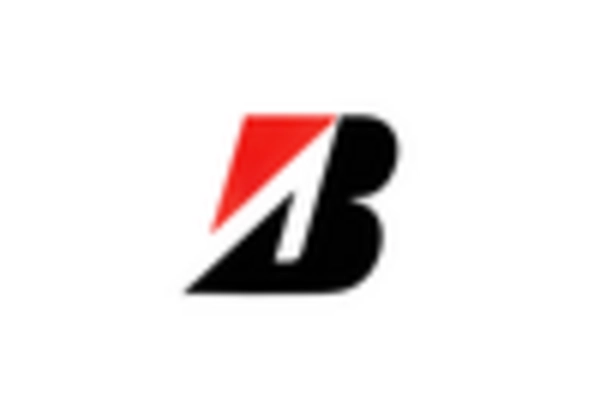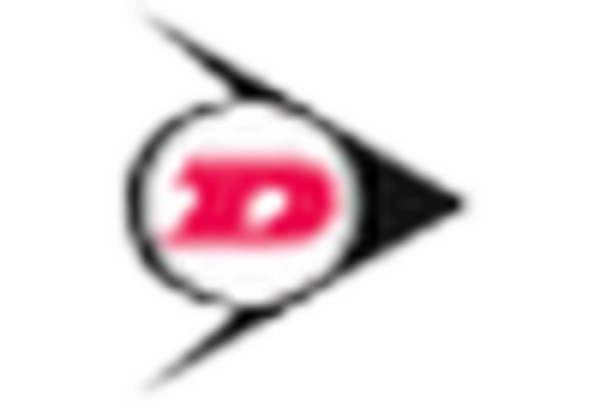-
EXECUTIVE SUMMARY
-
MARKET ATTRACTIVENESS ANALYSIS
- GLOBAL AUTOMOTIVE TIRE MARKET, BY RIM SIZE
- GLOBAL AUTOMOTIVE TIRE MARKET, BY SEASON
- GLOBAL AUTOMOTIVE TIRE MARKET, BY PROPULSION TYPE
- GLOBAL AUTOMOTIVE TIRE MARKET, BY VEHICLE TYPE
- GLOBAL AUTOMOTIVE TIRE MARKET, BY DISTRIBUTION CHANNEL
- GLOBAL AUTOMOTIVE TIRE MARKET, BY REGION
-
MARKET INTRODUCTION
-
DEFINITION
-
SCOPE OF THE STUDY
-
MARKET STRUCTURE
-
KEY BUYING CRITERIA
-
RESEARCH METHODOLOGY
-
RESEARCH PROCESS
-
PRIMARY RESEARCH
-
SECONDARY RESEARCH
-
MARKET SIZE ESTIMATION
-
TOP-DOWN AND BOTTOM-UP APPROACH
-
FORECAST MODEL
-
LIST OF ASSUMPTIONS
-
MARKET DYNAMICS
-
INTRODUCTION
-
DRIVERS
- ROAD ACCIDENT DEATHS
- GOVERNMENT REGULATIONS REGARDING TIRE LABELING
- INCREASING DEMAND FOR FUEL-EFFICIENT TIRES
- DRIVERS IMPACT ANALYSIS
-
RESTRAINT
- INCREASING RAW MATERIAL PRICES
- RESTRAINT IMPACT ANALYSIS
-
OPPORTUNITY
- GROWING DEMAND FOR GREEN TIRES IN FLEETS
-
TECHNOLOGY TRENDS
- GREEN TIRE ANALYSIS
-
COVID-19 IMPACT ANALYSIS
- ECONOMIC IMPACT ON AUTOMOTIVE INDUSTRY
- IMPACT ON AUTOMOTIVE PRODUCTION
- IMPACT ON AUTOMOTIVE TIRE MARKET
- IMPACT ON WORLD TRADE
-
MARKET FACTOR ANALYSIS
-
PORTER’S FIVE FORCES MODEL
- THREAT OF NEW ENTRANTS
- BARGAINING POWER OF SUPPLIERS
- THREAT OF SUBSTITUTES
- BARGAINING POWER OF BUYERS
- INTENSITY OF RIVALRY
-
SUPPLY CHAIN ANALYSIS
- DESIGN & DEVELOPMENT
- RAW MATERIAL SUPPLY
- MANUFACTURE
- DISTRIBUTION
- END USE
-
GLOBAL AUTOMOTIVE TIRE MARKET, BY RIM SIZE
-
OVERVIEW
-
13”–15"
-
16”–18"
-
19”–21"
-
>21"
-
GLOBAL AUTOMOTIVE TIRE MARKET, BY DISTRIBUTION CHANNEL
-
OVERVIEW
-
OEM
-
AFTERMARKET
-
GLOBAL AUTOMOTIVE TIRE MARKET, BY VEHICLE TYPE
-
OVERVIEW
-
PASSENGER CARS
-
LCV
-
HCV
-
GLOBAL AUTOMOTIVE TIRE MARKET, BY SEASON
-
OVERVIEW
-
WINTER
-
SUMMER
-
ALL SEASON
-
GLOBAL AUTOMOTIVE TIRE MARKET, BY PROPULSION TYPE
-
OVERVIEW
-
EV
-
ICE
-
GLOBAL AUTOMOTIVE TIRE MARKET, BY REGION
-
OVERVIEW
-
NORTH AMERICA
- US
- CANADA
- MEXICO
-
EUROPE
- GERMANY
- UK
- FRANCE
- SPAIN
- ITALY
- REST OF EUROPE
-
ASIA-PACIFIC
- CHINA
- JAPAN
- INDIA
- REST OF ASIA-PACIFIC
-
MIDDLE EAST & AFRICA (MEA)
-
SOUTH AMERICA
-
COMPETITIVE LANDSCAPE
-
COMPETITIVE OVERVIEW
-
MAJOR GROWTH STRATEGY IN THE GLOBAL AUTOMOTIVE TIRE MARKET
-
COMPETITIVE BENCHMARKING
-
MARKET SHARE ANALYSIS
-
KEY DEVELOPMENTS IN THE GLOBAL AUTOMOTIVE TIRE MARKET
- KEY DEVELOPMENTS: MERGERS & ACQUISITIONS
- KEY DEVELOPMENTS: CONTRACTS & AGREEMENTS
- KEY DEVELOPMENTS: PARTNERSHIPS
- KEY DEVELOPMENTS: EXPANSIONS
- KEY DEVELOPMENTS: PRODUCT DEVELOPMENTS/LAUNCHES
-
COMPANY PROFILES
-
BRIDGESTONE
- COMPANY OVERVIEW
- FINANCIAL OVERVIEW
- PRODUCTS OFFERED
- KEY DEVELOPMENTS
- SWOT ANALYSIS
- KEY STRATEGIES
-
MICHELIN
- COMPANY OVERVIEW
- FINANCIAL OVERVIEW
- PRODUCTS OFFERED
- KEY DEVELOPMENTS
- SWOT ANALYSIS
- KEY STRATEGIES
-
CONTINENTAL AG
- COMPANY OVERVIEW
- FINANCIAL OVERVIEW
- PRODUCTS OFFERED
- KEY DEVELOPMENTS
- SWOT ANALYSIS
- KEY STRATEGIES
-
PIRELLI & C. S.P.A
- COMPANY OVERVIEW
- FINANCIAL OVERVIEW
- PRODUCTS OFFERED
- KEY DEVELOPMENTS
- SWOT ANALYSIS
- KEY STRATEGIES
-
HANKOOK TIRE
- COMPANY OVERVIEW
- FINANCIAL OVERVIEW
- PRODUCTS OFFERED
- KEY DEVELOPMENTS
- SWOT ANALYSIS
- KEY STRATEGIES
-
TOYO TIRE CORPORATION
- COMPANY OVERVIEW
- FINANCIAL OVERVIEW
- PRODUCTS OFFERED
- KEY DEVELOPMENTS
-
GITI TIRE
- COMPANY OVERVIEW
- FINANCIAL OVERVIEW
- PRODUCTS OFFERED
- KEY DEVELOPMENTS
-
KUMHO TIRE
- COMPANY OVERVIEW
- FINANCIAL OVERVIEW
- PRODUCTS OFFERED
- KEY DEVELOPMENTS
-
NEXEN TIRE
- COMPANY OVERVIEW
- FINANCIAL OVERVIEW
- PRODUCTS OFFERED
- KEY DEVELOPMENTS
-
MAXXIS INTERNATIONAL
- COMPANY OVERVIEW
- FINANCIAL OVERVIEW
- PRODUCTS OFFERED
- KEY DEVELOPMENTS
-
COST BREAKDOWN ANALYSIS
-
COST STRUCTURE: AUTOMOTIVE TIRES
- AUTOMOTIVE TIRE FINAL COST
-
APPENDIX
-
DATA SOURCES
-
LIST OF TABLES
-
LIST OF ASSUMPTIONS
-
GLOBAL AUTOMOTIVE TIRE: MARKET ESTIMATES & FORECAST, BY RIM SIZE, 2024–2032 (USD MILLION)
-
GLOBAL AUTOMOTIVE TIRE: MARKET ESTIMATES & FORECAST, BY RIM SIZE, 2024–2032 (MILLION UNITS)
-
GLOBAL AUTOMOTIVE TIRE: MARKET ESTIMATES & FORECAST, BY DISTRIBUTION CHANNEL, 2024–2032 (USD MILLION)
-
GLOBAL AUTOMOTIVE TIRE: MARKET ESTIMATES & FORECAST, BY DISTRIBUTION CHANNEL, 2024–2032 (MILLION UNITS)
-
GLOBAL AUTOMOTIVE TIRE: MARKET ESTIMATES & FORECAST, BY VEHICLE TYPE, 2024–2032 (USD MILLION)
-
GLOBAL AUTOMOTIVE TIRE: MARKET ESTIMATES & FORECAST, BY FUSIBLE MATERIAL, 2024–2032 (MILLION UNITS)
-
GLOBAL AUTOMOTIVE TIRE: MARKET ESTIMATES & FORECAST, BY SEASON, 2024–2032 (USD MILLION)
-
GLOBAL AUTOMOTIVE TIRE: MARKET ESTIMATES & FORECAST, BY SEASON, 2024–2032 (MILLION UNITS)
-
GLOBAL AUTOMOTIVE TIRE: MARKET ESTIMATES & FORECAST, BY PROPULSION TYPE, 2024–2032 (USD MILLION)
-
GLOBAL AUTOMOTIVE TIRE: MARKET ESTIMATES & FORECAST, BY PROPULSION TYPE, 2024–2032 (MILLION UNITS)
-
GLOBAL AUTOMOTIVE TIRE MARKET, BY REGION, 2024–2032 (USD MILLION)
-
GLOBAL AUTOMOTIVE TIRE MARKET, BY REGION, 2024–2032 (MILLION UNITS)
-
NORTH AMERICA: AUTOMOTIVE TIRE MARKET, BY COUNTRY, 2024–2032 (USD MILLION)
-
NORTH AMERICA: AUTOMOTIVE TIRE MARKET, BY COUNTRY, 2024–2032 (MILLION UNITS)
-
NORTH AMERICA: AUTOMOTIVE TIRE MARKET ESTIMATES & FORECAST, BY RIM SIZE, 2024–2032 (USD MILLION)
-
NORTH AMERICA: AUTOMOTIVE TIRE MARKET ESTIMATES & FORECAST, BY RIM SIZE, 2024–2032 (MILLION UNITS)
-
NORTH AMERICA: AUTOMOTIVE TIRE MARKET ESTIMATES & FORECAST, BY DISTRIBUTION CHANNEL, 2024–2032 (USD MILLION)
-
NORTH AMERICA: AUTOMOTIVE TIRE MARKET ESTIMATES & FORECAST, BY DISTRIBUTION CHANNEL, 2024–2032 (MILLION UNITS)
-
NORTH AMERICA: AUTOMOTIVE TIRE MARKET ESTIMATES & FORECAST, BY VEHICLE TYPE, 2024–2032 (USD MILLION)
-
NORTH AMERICA: AUTOMOTIVE TIRE MARKET ESTIMATES & FORECAST, BY VEHICLE TYPE, 2024–2032 (MILLION UNITS)
-
NORTH AMERICA: AUTOMOTIVE TIRE MARKET ESTIMATES & FORECAST, BY SEASON, 2024–2032 (USD MILLION)
-
NORTH AMERICA: AUTOMOTIVE TIRE MARKET ESTIMATES & FORECAST, BY SEASON, 2024–2032 (MILLION UNITS)
-
NORTH AMERICA: AUTOMOTIVE TIRE MARKET ESTIMATES & FORECAST, BY PROPULSION TYPE, 2024–2032 (USD MILLION)
-
NORTH AMERICA: AUTOMOTIVE TIRE MARKET ESTIMATES & FORECAST, BY PROPULSION TYPE, 2024–2032 (MILLION UNITS)
-
US: AUTOMOTIVE TIRE MARKET ESTIMATES & FORECAST, BY RIM SIZE, 2024–2032 (USD MILLION)
-
US: AUTOMOTIVE TIRE MARKET ESTIMATES & FORECAST, BY RIM SIZE, 2024–2032 (MILLION UNITS)
-
US: AUTOMOTIVE TIRE MARKET ESTIMATES & FORECAST, BY DISTRIBUTION CHANNEL, 2024–2032 (USD MILLION)
-
US: AUTOMOTIVE TIRE MARKET ESTIMATES & FORECAST, BY DISTRIBUTION CHANNEL, 2024–2032 (MILLION UNITS)
-
US: AUTOMOTIVE TIRE MARKET ESTIMATES & FORECAST, BY VEHICLE TYPE, 2024–2032 (USD MILLION)
-
US: AUTOMOTIVE TIRE MARKET ESTIMATES & FORECAST, BY VEHICLE TYPE, 2024–2032 (MILLION UNITS)
-
US: AUTOMOTIVE TIRE MARKET ESTIMATES & FORECAST, BY SEASON, 2024–2032 (USD MILLION)
-
US: AUTOMOTIVE TIRE MARKET ESTIMATES & FORECAST, BY SEASON, 2024–2032 (MILLION UNITS)
-
US: AUTOMOTIVE TIRE MARKET ESTIMATES & FORECAST, BY PROPULSION TYPE, 2024–2032 (USD MILLION)
-
US: AUTOMOTIVE TIRE MARKET ESTIMATES & FORECAST, BY PROPULSION TYPE, 2024–2032 (MILLION UNITS)
-
CANADA: AUTOMOTIVE TIRE MARKET ESTIMATES & FORECAST, BY RIM SIZE, 2024–2032 (USD MILLION)
-
CANADA: AUTOMOTIVE TIRE MARKET ESTIMATES & FORECAST, BY RIM SIZE, 2024–2032 (MILLION UNITS)
-
CANADA: AUTOMOTIVE TIRE MARKET ESTIMATES & FORECAST, BY DISTRIBUTION CHANNEL, 2024–2032 (USD MILLION)
-
CANADA: AUTOMOTIVE TIRE MARKET ESTIMATES & FORECAST, BY DISTRIBUTION CHANNEL, 2024–2032 (MILLION UNITS)
-
CANADA: AUTOMOTIVE TIRE MARKET ESTIMATES & FORECAST, BY VEHICLE TYPE, 2024–2032 (USD MILLION)
-
CANADA: AUTOMOTIVE TIRE MARKET ESTIMATES & FORECAST, BY VEHICLE TYPE, 2024–2032 (MILLION UNITS)
-
CANADA: AUTOMOTIVE TIRE MARKET ESTIMATES & FORECAST, BY SEASON, 2024–2032 (USD MILLION)
-
CANADA: AUTOMOTIVE TIRE MARKET ESTIMATES & FORECAST, BY SEASON, 2024–2032 (MILLION UNITS)
-
CANADA: AUTOMOTIVE TIRE MARKET ESTIMATES & FORECAST, BY PROPULSION TYPE, 2024–2032 (USD MILLION)
-
CANADA: AUTOMOTIVE TIRE MARKET ESTIMATES & FORECAST, BY PROPULSION TYPE, 2024–2032 (MILLION UNITS)
-
MEXICO: AUTOMOTIVE TIRE MARKET ESTIMATES & FORECAST, BY RIM SIZE, 2024–2032 (USD MILLION)
-
MEXICO: AUTOMOTIVE TIRE MARKET ESTIMATES & FORECAST, BY RIM SIZE, 2024–2032 (MILLION UNITS)
-
MEXICO: AUTOMOTIVE TIRE MARKET ESTIMATES & FORECAST, BY DISTRIBUTION CHANNEL, 2024–2032 (USD MILLION)
-
MEXICO: AUTOMOTIVE TIRE MARKET ESTIMATES & FORECAST, BY DISTRIBUTION CHANNEL, 2024–2032 (MILLION UNITS)
-
MEXICO: AUTOMOTIVE TIRE MARKET ESTIMATES & FORECAST, BY VEHICLE TYPE, 2024–2032 (USD MILLION)
-
MEXICO: AUTOMOTIVE TIRE MARKET ESTIMATES & FORECAST, BY VEHICLE TYPE, 2024–2032 (MILLION UNITS)
-
MEXICO: AUTOMOTIVE TIRE MARKET ESTIMATES & FORECAST, BY SEASON, 2024–2032 (USD MILLION)
-
MEXICO: AUTOMOTIVE TIRE MARKET ESTIMATES & FORECAST, BY SEASON, 2024–2032 (MILLION UNITS)
-
MEXICO: AUTOMOTIVE TIRE MARKET ESTIMATES & FORECAST, BY PROPULSION TYPE, 2024–2032 (USD MILLION)
-
MEXICO: AUTOMOTIVE TIRE MARKET ESTIMATES & FORECAST, BY PROPULSION TYPE, 2024–2032 (MILLION UNITS)
-
EUROPE: AUTOMOTIVE TIRE MARKET, BY COUNTRY, 2024–2032 (USD MILLION)
-
EUROPE: AUTOMOTIVE TIRE MARKET, BY COUNTRY, 2024–2032 (MILLION UNITS)
-
EUROPE: AUTOMOTIVE TIRE MARKET ESTIMATES & FORECAST, BY RIM SIZE, 2024–2032 (USD MILLION)
-
EUROPE: AUTOMOTIVE TIRE MARKET ESTIMATES & FORECAST, BY RIM SIZE, 2024–2032 (MILLION UNITS)
-
EUROPE: AUTOMOTIVE TIRE MARKET ESTIMATES & FORECAST, BY DISTRIBUTION CHANNEL, 2024–2032 (USD MILLION)
-
EUROPE: AUTOMOTIVE TIRE MARKET ESTIMATES & FORECAST, BY DISTRIBUTION CHANNEL, 2024–2032 (MILLION UNITS)
-
EUROPE: AUTOMOTIVE TIRE MARKET ESTIMATES & FORECAST, BY VEHICLE TYPE, 2024–2032 (USD MILLION)
-
EUROPE: AUTOMOTIVE TIRE MARKET ESTIMATES & FORECAST, BY VEHICLE TYPE, 2024–2032 (MILLION UNITS)
-
EUROPE: AUTOMOTIVE TIRE MARKET ESTIMATES & FORECAST, BY SEASON, 2024–2032 (USD MILLION)
-
EUROPE: AUTOMOTIVE TIRE MARKET ESTIMATES & FORECAST, BY SEASON, 2024–2032 (MILLION UNITS)
-
EUROPE: AUTOMOTIVE TIRE MARKET ESTIMATES & FORECAST, BY PROPULSION TYPE, 2024–2032 (USD MILLION)
-
EUROPE: AUTOMOTIVE TIRE MARKET ESTIMATES & FORECAST, BY PROPULSION TYPE, 2024–2032 (MILLION UNITS)
-
GERMANY: AUTOMOTIVE TIRE MARKET ESTIMATES & FORECAST, BY RIM SIZE, 2024–2032 (USD MILLION)
-
GERMANY: AUTOMOTIVE TIRE MARKET ESTIMATES & FORECAST, BY RIM SIZE, 2024–2032 (MILLION UNITS)
-
GERMANY: AUTOMOTIVE TIRE MARKET ESTIMATES & FORECAST, BY DISTRIBUTION CHANNEL, 2024–2032 (USD MILLION)
-
GERMANY: AUTOMOTIVE TIRE MARKET ESTIMATES & FORECAST, BY DISTRIBUTION CHANNEL, 2024–2032 (MILLION UNITS)
-
GERMANY: AUTOMOTIVE TIRE MARKET ESTIMATES & FORECAST, BY VEHICLE TYPE, 2024–2032 (USD MILLION)
-
GERMANY: AUTOMOTIVE TIRE MARKET ESTIMATES & FORECAST, BY VEHICLE TYPE, 2024–2032 (MILLION UNITS)
-
GERMANY: AUTOMOTIVE TIRE MARKET ESTIMATES & FORECAST, BY SEASON, 2024–2032 (USD MILLION)
-
GERMANY: AUTOMOTIVE TIRE MARKET ESTIMATES & FORECAST, BY SEASON, 2024–2032 (MILLION UNITS)
-
GERMANY: AUTOMOTIVE TIRE MARKET ESTIMATES & FORECAST, BY PROPULSION TYPE, 2024–2032 (USD MILLION)
-
GERMANY: AUTOMOTIVE TIRE MARKET ESTIMATES & FORECAST, BY PROPULSION TYPE, 2024–2032 (MILLION UNITS)
-
UK: AUTOMOTIVE TIRE MARKET ESTIMATES & FORECAST, BY RIM SIZE, 2024–2032 (USD MILLION)
-
UK: AUTOMOTIVE TIRE MARKET ESTIMATES & FORECAST, BY RIM SIZE, 2024–2032 (MILLION UNITS)
-
UK: AUTOMOTIVE TIRE MARKET ESTIMATES & FORECAST, BY DISTRIBUTION CHANNEL, 2024–2032 (USD MILLION)
-
UK: AUTOMOTIVE TIRE MARKET ESTIMATES & FORECAST, BY DISTRIBUTION CHANNEL, 2024–2032 (MILLION UNITS)
-
UK: AUTOMOTIVE TIRE MARKET ESTIMATES & FORECAST, BY VEHICLE TYPE, 2024–2032 (USD MILLION)
-
UK: AUTOMOTIVE TIRE MARKET ESTIMATES & FORECAST, BY VEHICLE TYPE, 2024–2032 (MILLION UNITS)
-
UK: AUTOMOTIVE TIRE MARKET ESTIMATES & FORECAST, BY SEASON, 2024–2032 (USD MILLION)
-
UK: AUTOMOTIVE TIRE MARKET ESTIMATES & FORECAST, BY SEASON, 2024–2032 (MILLION UNITS)
-
UK: AUTOMOTIVE TIRE MARKET ESTIMATES & FORECAST, BY PROPULSION TYPE, 2024–2032 (USD MILLION)
-
UK: AUTOMOTIVE TIRE MARKET ESTIMATES & FORECAST, BY PROPULSION TYPE, 2024–2032 (MILLION UNITS)
-
FRANCE: AUTOMOTIVE TIRE MARKET ESTIMATES & FORECAST, BY RIM SIZE, 2024–2032 (USD MILLION)
-
FRANCE: AUTOMOTIVE TIRE MARKET ESTIMATES & FORECAST, BY RIM SIZE, 2024–2032 (MILLION UNITS)
-
FRANCE: AUTOMOTIVE TIRE MARKET ESTIMATES & FORECAST, BY DISTRIBUTION CHANNEL, 2024–2032 (USD MILLION)
-
FRANCE: AUTOMOTIVE TIRE MARKET ESTIMATES & FORECAST, BY DISTRIBUTION CHANNEL, 2024–2032 (MILLION UNITS)
-
FRANCE: AUTOMOTIVE TIRE MARKET ESTIMATES & FORECAST, BY VEHICLE TYPE, 2024–2032 (USD MILLION)
-
FRANCE: AUTOMOTIVE TIRE MARKET ESTIMATES & FORECAST, BY VEHICLE TYPE, 2024–2032 (MILLION UNITS)
-
FRANCE: AUTOMOTIVE TIRE MARKET ESTIMATES & FORECAST, BY SEASON, 2024–2032 (USD MILLION)
-
FRANCE: AUTOMOTIVE TIRE MARKET ESTIMATES & FORECAST, BY SEASON, 2024–2032 (MILLION UNITS)
-
FRANCE: AUTOMOTIVE TIRE MARKET ESTIMATES & FORECAST, BY PROPULSION TYPE, 2024–2032 (USD MILLION)
-
FRANCE: AUTOMOTIVE TIRE MARKET ESTIMATES & FORECAST, BY PROPULSION TYPE, 2024–2032 (MILLION UNITS)
-
SPAIN: AUTOMOTIVE TIRE MARKET ESTIMATES & FORECAST, BY RIM SIZE, 2024–2032 (USD MILLION)
-
SPAIN: AUTOMOTIVE TIRE MARKET ESTIMATES & FORECAST, BY RIM SIZE, 2024–2032 (MILLION UNITS)
-
SPAIN: AUTOMOTIVE TIRE MARKET ESTIMATES & FORECAST, BY DISTRIBUTION CHANNEL, 2024–2032 (USD MILLION)
-
SPAIN: AUTOMOTIVE TIRE MARKET ESTIMATES & FORECAST, BY DISTRIBUTION CHANNEL, 2024–2032 (MILLION UNITS)
-
SPAIN: AUTOMOTIVE TIRE MARKET ESTIMATES & FORECAST, BY VEHICLE TYPE, 2024–2032 (USD MILLION)
-
SPAIN: AUTOMOTIVE TIRE MARKET ESTIMATES & FORECAST, BY VEHICLE TYPE, 2024–2032 (MILLION UNITS)
-
SPAIN: AUTOMOTIVE TIRE MARKET ESTIMATES & FORECAST, BY SEASON, 2024–2032 (USD MILLION)
-
SPAIN: AUTOMOTIVE TIRE MARKET ESTIMATES & FORECAST, BY SEASON, 2024–2032 (MILLION UNITS)
-
SPAIN: AUTOMOTIVE TIRE MARKET ESTIMATES & FORECAST, BY PROPULSION TYPE, 2024–2032 (USD MILLION)
-
SPAIN: AUTOMOTIVE TIRE MARKET ESTIMATES & FORECAST, BY PROPULSION TYPE, 2024–2032 (MILLION UNITS)
-
ITALY: AUTOMOTIVE TIRE MARKET ESTIMATES & FORECAST, BY RIM SIZE, 2024–2032 (USD MILLION)
-
ITALY: AUTOMOTIVE TIRE MARKET ESTIMATES & FORECAST, BY RIM SIZE, 2024–2032 (MILLION UNITS)
-
ITALY: AUTOMOTIVE TIRE MARKET ESTIMATES & FORECAST, BY DISTRIBUTION CHANNEL, 2024–2032 (USD MILLION)
-
ITALY: AUTOMOTIVE TIRE MARKET ESTIMATES & FORECAST, BY DISTRIBUTION CHANNEL, 2024–2032 (MILLION UNITS)
-
ITALY: AUTOMOTIVE TIRE MARKET ESTIMATES & FORECAST, BY VEHICLE TYPE, 2024–2032 (USD MILLION)
-
ITALY: AUTOMOTIVE TIRE MARKET ESTIMATES & FORECAST, BY VEHICLE TYPE, 2024–2032 (MILLION UNITS)
-
ITALY: AUTOMOTIVE TIRE MARKET ESTIMATES & FORECAST, BY SEASON, 2024–2032 (USD MILLION)
-
ITALY: AUTOMOTIVE TIRE MARKET ESTIMATES & FORECAST, BY SEASON, 2024–2032 (MILLION UNITS)
-
ITALY: AUTOMOTIVE TIRE MARKET ESTIMATES & FORECAST, BY PROPULSION TYPE, 2024–2032 (USD MILLION)
-
ITALY: AUTOMOTIVE TIRE MARKET ESTIMATES & FORECAST, BY PROPULSION TYPE, 2024–2032 (MILLION UNITS)
-
REST OF EUROPE: AUTOMOTIVE TIRE MARKET ESTIMATES & FORECAST, BY RIM SIZE, 2024–2032 (USD MILLION)
-
REST OF EUROPE: AUTOMOTIVE TIRE MARKET ESTIMATES & FORECAST, BY RIM SIZE, 2024–2032 (MILLION UNITS)
-
REST OF EUROPE: AUTOMOTIVE TIRE MARKET ESTIMATES & FORECAST, BY DISTRIBUTION CHANNEL, 2024–2032 (USD MILLION)
-
REST OF EUROPE: AUTOMOTIVE TIRE MARKET ESTIMATES & FORECAST, BY DISTRIBUTION CHANNEL, 2024–2032 (MILLION UNITS)
-
REST OF EUROPE: AUTOMOTIVE TIRE MARKET ESTIMATES & FORECAST, BY VEHICLE TYPE, 2024–2032 (USD MILLION)
-
REST OF EUROPE: AUTOMOTIVE TIRE MARKET ESTIMATES & FORECAST, BY VEHICLE TYPE, 2024–2032 (MILLION UNITS)
-
REST OF EUROPE: AUTOMOTIVE TIRE MARKET ESTIMATES & FORECAST, BY SEASON, 2024–2032 (USD MILLION)
-
REST OF EUROPE: AUTOMOTIVE TIRE MARKET ESTIMATES & FORECAST, BY SEASON, 2024–2032 (MILLION UNITS)
-
REST OF EUROPE: AUTOMOTIVE TIRE MARKET ESTIMATES & FORECAST, BY PROPULSION TYPE, 2024–2032 (USD MILLION)
-
REST OF EUROPE: AUTOMOTIVE TIRE MARKET ESTIMATES & FORECAST, BY PROPULSION TYPE, 2024–2032 (MILLION UNITS)
-
ASIA-PACIFIC: AUTOMOTIVE TIRE MARKET, BY COUNTRY, 2024–2032 (USD MILLION)
-
ASIA-PACIFIC: AUTOMOTIVE TIRE MARKET, BY COUNTRY, 2024–2032 (MILLION UNITS)
-
ASIA-PACIFIC: AUTOMOTIVE TIRE MARKET ESTIMATES & FORECAST, BY RIM SIZE, 2024–2032 (USD MILLION)
-
ASIA-PACIFIC: AUTOMOTIVE TIRE MARKET ESTIMATES & FORECAST, BY RIM SIZE, 2024–2032 (MILLION UNITS)
-
ASIA-PACIFIC: AUTOMOTIVE TIRE MARKET ESTIMATES & FORECAST, BY DISTRIBUTION CHANNEL, 2024–2032 (USD MILLION)
-
ASIA-PACIFIC: AUTOMOTIVE TIRE MARKET ESTIMATES & FORECAST, BY DISTRIBUTION CHANNEL, 2024–2032 (MILLION UNITS)
-
ASIA-PACIFIC: AUTOMOTIVE TIRE MARKET ESTIMATES & FORECAST, BY VEHICLE TYPE, 2024–2032 (USD MILLION)
-
ASIA-PACIFIC: AUTOMOTIVE TIRE MARKET ESTIMATES & FORECAST, BY VEHICLE TYPE, 2024–2032 (MILLION UNITS)
-
ASIA-PACIFIC: AUTOMOTIVE TIRE MARKET ESTIMATES & FORECAST, BY SEASON, 2024–2032 (USD MILLION)
-
ASIA-PACIFIC: AUTOMOTIVE TIRE MARKET ESTIMATES & FORECAST, BY SEASON, 2024–2032 (MILLION UNITS)
-
ASIA-PACIFIC: AUTOMOTIVE TIRE MARKET ESTIMATES & FORECAST, BY PROPULSION TYPE, 2024–2032 (USD MILLION)
-
ASIA-PACIFIC: AUTOMOTIVE TIRE MARKET ESTIMATES & FORECAST, BY PROPULSION TYPE, 2024–2032 (MILLION UNITS)
-
CHINA: AUTOMOTIVE TIRE MARKET ESTIMATES & FORECAST, BY RIM SIZE, 2024–2032 (USD MILLION)
-
CHINA: AUTOMOTIVE TIRE MARKET ESTIMATES & FORECAST, BY RIM SIZE, 2024–2032 (MILLION UNITS)
-
CHINA: AUTOMOTIVE TIRE MARKET ESTIMATES & FORECAST, BY DISTRIBUTION CHANNEL, 2024–2032 (USD MILLION)
-
CHINA: AUTOMOTIVE TIRE MARKET ESTIMATES & FORECAST, BY DISTRIBUTION CHANNEL, 2024–2032 (MILLION UNITS)
-
CHINA: AUTOMOTIVE TIRE MARKET ESTIMATES & FORECAST, BY VEHICLE TYPE, 2024–2032 (USD MILLION)
-
CHINA: AUTOMOTIVE TIRE MARKET ESTIMATES & FORECAST, BY VEHICLE TYPE, 2024–2032 (MILLION UNITS)
-
CHINA: AUTOMOTIVE TIRE MARKET ESTIMATES & FORECAST, BY SEASON, 2024–2032 (USD MILLION)
-
CHINA: AUTOMOTIVE TIRE MARKET ESTIMATES & FORECAST, BY SEASON, 2024–2032 (MILLION UNITS)
-
CHINA: AUTOMOTIVE TIRE MARKET ESTIMATES & FORECAST, BY PROPULSION TYPE, 2024–2032 (USD MILLION)
-
CHINA: AUTOMOTIVE TIRE MARKET ESTIMATES & FORECAST, BY PROPULSION TYPE, 2024–2032 (MILLION UNITS)
-
JAPAN: AUTOMOTIVE TIRE MARKET ESTIMATES & FORECAST, BY RIM SIZE, 2024–2032 (USD MILLION)
-
JAPAN: AUTOMOTIVE TIRE MARKET ESTIMATES & FORECAST, BY RIM SIZE, 2024–2032 (MILLION UNITS)
-
JAPAN: AUTOMOTIVE TIRE MARKET ESTIMATES & FORECAST, BY DISTRIBUTION CHANNEL, 2024–2032 (USD MILLION)
-
JAPAN: AUTOMOTIVE TIRE MARKET ESTIMATES & FORECAST, BY DISTRIBUTION CHANNEL, 2024–2032 (MILLION UNITS)
-
JAPAN: AUTOMOTIVE TIRE MARKET ESTIMATES & FORECAST, BY VEHICLE TYPE, 2024–2032 (USD MILLION)
-
JAPAN: AUTOMOTIVE TIRE MARKET ESTIMATES & FORECAST, BY VEHICLE TYPE, 2024–2032 (MILLION UNITS)
-
JAPAN: AUTOMOTIVE TIRE MARKET ESTIMATES & FORECAST, BY SEASON, 2024–2032 (USD MILLION)
-
JAPAN: AUTOMOTIVE TIRE MARKET ESTIMATES & FORECAST, BY SEASON, 2024–2032 (MILLION UNITS)
-
JAPAN: AUTOMOTIVE TIRE MARKET ESTIMATES & FORECAST, BY PROPULSION TYPE, 2024–2032 (USD MILLION)
-
JAPAN: AUTOMOTIVE TIRE MARKET ESTIMATES & FORECAST, BY PROPULSION TYPE, 2024–2032 (MILLION UNITS)
-
INDIA: AUTOMOTIVE TIRE MARKET ESTIMATES & FORECAST, BY RIM SIZE, 2024–2032 (USD MILLION)
-
INDIA: AUTOMOTIVE TIRE MARKET ESTIMATES & FORECAST, BY RIM SIZE, 2024–2032 (MILLION UNITS)
-
INDIA: AUTOMOTIVE TIRE MARKET ESTIMATES & FORECAST, BY DISTRIBUTION CHANNEL, 2024–2032 (USD MILLION)
-
INDIA: AUTOMOTIVE TIRE MARKET ESTIMATES & FORECAST, BY DISTRIBUTION CHANNEL, 2024–2032 (MILLION UNITS)
-
INDIA: AUTOMOTIVE TIRE MARKET ESTIMATES & FORECAST, BY VEHICLE TYPE, 2024–2032 (USD MILLION)
-
INDIA: AUTOMOTIVE TIRE MARKET ESTIMATES & FORECAST, BY VEHICLE TYPE, 2024–2032 (MILLION UNITS)
-
INDIA: AUTOMOTIVE TIRE MARKET ESTIMATES & FORECAST, BY SEASON, 2024–2032 (USD MILLION)
-
INDIA: AUTOMOTIVE TIRE MARKET ESTIMATES & FORECAST, BY SEASON, 2024–2032 (MILLION UNITS)
-
INDIA: AUTOMOTIVE TIRE MARKET ESTIMATES & FORECAST, BY PROPULSION TYPE, 2024–2032 (USD MILLION)
-
INDIA: AUTOMOTIVE TIRE MARKET ESTIMATES & FORECAST, BY PROPULSION TYPE, 2024–2032 (MILLION UNITS)
-
REST OF ASIA-PACIFIC: AUTOMOTIVE TIRE MARKET ESTIMATES & FORECAST, BY RIM SIZE, 2024–2032 (USD MILLION)
-
REST OF ASIA-PACIFIC: AUTOMOTIVE TIRE MARKET ESTIMATES & FORECAST, BY RIM SIZE, 2024–2032 (MILLION UNITS)
-
REST OF ASIA-PACIFIC: AUTOMOTIVE TIRE MARKET ESTIMATES & FORECAST, BY DISTRIBUTION CHANNEL, 2024–2032 (USD MILLION)
-
REST OF ASIA-PACIFIC: AUTOMOTIVE TIRE MARKET ESTIMATES & FORECAST, BY DISTRIBUTION CHANNEL, 2024–2032 (MILLION UNITS)
-
REST OF ASIA-PACIFIC: AUTOMOTIVE TIRE MARKET ESTIMATES & FORECAST, BY VEHICLE TYPE, 2024–2032 (USD MILLION)
-
REST OF ASIA-PACIFIC: AUTOMOTIVE TIRE MARKET ESTIMATES & FORECAST, BY VEHICLE TYPE, 2024–2032 (MILLION UNITS)
-
REST OF ASIA-PACIFIC: AUTOMOTIVE TIRE MARKET ESTIMATES & FORECAST, BY SEASON, 2024–2032 (USD MILLION)
-
REST OF ASIA-PACIFIC: AUTOMOTIVE TIRE MARKET ESTIMATES & FORECAST, BY SEASON, 2024–2032 (MILLION UNITS)
-
REST OF ASIA-PACIFIC: AUTOMOTIVE TIRE MARKET ESTIMATES & FORECAST, BY PROPULSION TYPE, 2024–2032 (USD MILLION)
-
REST OF ASIA-PACIFIC: AUTOMOTIVE TIRE MARKET ESTIMATES & FORECAST, BY PROPULSION TYPE, 2024–2032 (MILLION UNITS)
-
MIDDLE EAST & AFRICA: AUTOMOTIVE TIRE MARKET ESTIMATES & FORECAST, BY RIM SIZE, 2024–2032 (USD MILLION)
-
MIDDLE EAST & AFRICA: AUTOMOTIVE TIRE MARKET ESTIMATES & FORECAST, BY RIM SIZE, 2024–2032 (MILLION UNITS)
-
MIDDLE EAST & AFRICA: AUTOMOTIVE TIRE MARKET ESTIMATES & FORECAST, BY DISTRIBUTION CHANNEL, 2024–2032 (USD MILLION)
-
MIDDLE EAST & AFRICA: AUTOMOTIVE TIRE MARKET ESTIMATES & FORECAST, BY DISTRIBUTION CHANNEL, 2024–2032 (MILLION UNITS)
-
MIDDLE EAST & AFRICA: AUTOMOTIVE TIRE MARKET ESTIMATES & FORECAST, BY VEHICLE TYPE, 2024–2032 (USD MILLION)121
-
MIDDLE EAST & AFRICA: AUTOMOTIVE TIRE MARKET ESTIMATES & FORECAST, BY VEHICLE TYPE, 2024–2032 (MILLION UNITS)
-
MIDDLE EAST & AFRICA: AUTOMOTIVE TIRE MARKET ESTIMATES & FORECAST, BY SEASON, 2024–2032 (USD MILLION)
-
MIDDLE EAST & AFRICA: AUTOMOTIVE TIRE MARKET ESTIMATES & FORECAST, BY SEASON, 2024–2032 (MILLION UNITS)
-
MIDDLE EAST & AFRICA: AUTOMOTIVE TIRE MARKET ESTIMATES & FORECAST, BY PROPULSION TYPE, 2024–2032 (USD MILLION)
-
MIDDLE EAST & AFRICA: AUTOMOTIVE TIRE MARKET ESTIMATES & FORECAST, BY PROPULSION TYPE, 2024–2032 (MILLION UNITS)
-
SOUTH AMERICA: AUTOMOTIVE TIRE MARKET ESTIMATES & FORECAST, BY RIM SIZE, 2024–2032 (USD MILLION)
-
SOUTH AMERICA: AUTOMOTIVE TIRE MARKET ESTIMATES & FORECAST, BY RIM SIZE, 2024–2032 (MILLION UNITS)
-
SOUTH AMERICA: AUTOMOTIVE TIRE MARKET ESTIMATES & FORECAST, BY DISTRIBUTION CHANNEL, 2024–2032 (USD MILLION)
-
SOUTH AMERICA: AUTOMOTIVE TIRE MARKET ESTIMATES & FORECAST, BY DISTRIBUTION CHANNEL, 2024–2032 (MILLION UNITS)
-
SOUTH AMERICA: AUTOMOTIVE TIRE MARKET ESTIMATES & FORECAST, BY VEHICLE TYPE, 2024–2032 (USD MILLION)
-
SOUTH AMERICA: AUTOMOTIVE TIRE MARKET ESTIMATES & FORECAST, BY VEHICLE TYPE, 2024–2032 (MILLION UNITS)
-
SOUTH AMERICA: AUTOMOTIVE TIRE MARKET ESTIMATES & FORECAST, BY SEASON, 2024–2032 (USD MILLION)
-
SOUTH AMERICA: AUTOMOTIVE TIRE MARKET ESTIMATES & FORECAST, BY SEASON, 2024–2032 (MILLION UNITS)
-
SOUTH AMERICA: AUTOMOTIVE TIRE MARKET ESTIMATES & FORECAST, BY PROPULSION TYPE, 2024–2032 (USD MILLION)
-
SOUTH AMERICA: AUTOMOTIVE TIRE MARKET ESTIMATES & FORECAST, BY PROPULSION TYPE, 2024–2032 (MILLION UNITS)
-
KEY DEVELOPMENTS: MERGERS & ACQUISITIONS
-
KEY DEVELOPMENTS: CONTRACTS & AGREEMENTS
-
KEY DEVELOPMENTS: PARTNERSHIPS
-
KEY DEVELOPMENTS: EXPANSIONS
-
KEY DEVELOPMENTS: PRODUCT DEVELOPMENTS/LAUNCHES
-
BRIDGESTONE: PRODUCTS OFFERED
-
BRIDGESTONE: KEY DEVELOPMENTS
-
MICHELIN: PRODUCTS OFFERED
-
MICHELIN: KEY DEVELOPMENTS
-
CONTINENTAL AG: PRODUCTS OFFERED
-
CONTINENTAL AG: KEY DEVELOPMENTS
-
PIRELLI & C. S.P.A: PRODUCTS OFFERED
-
PIRELLI & C. S.P.A: KEY DEVELOPMENTS
-
HANKOOK TIRE: PRODUCTS OFFE

















Leave a Comment